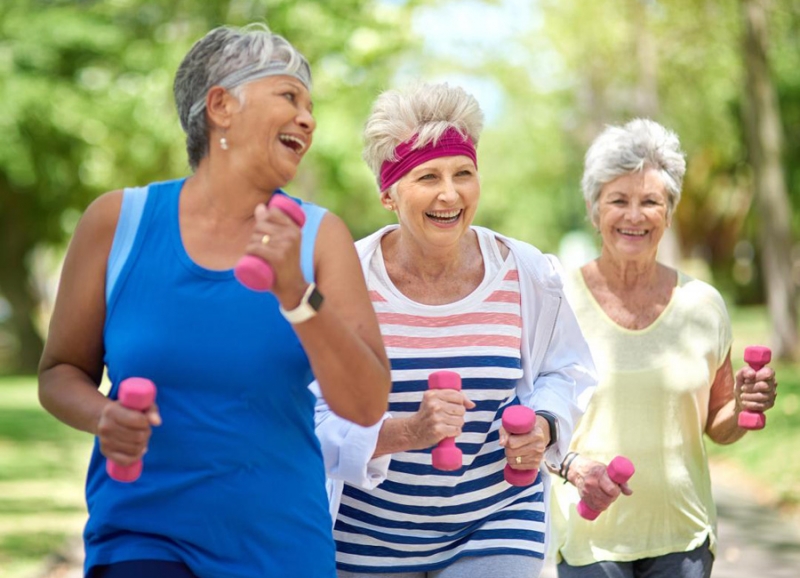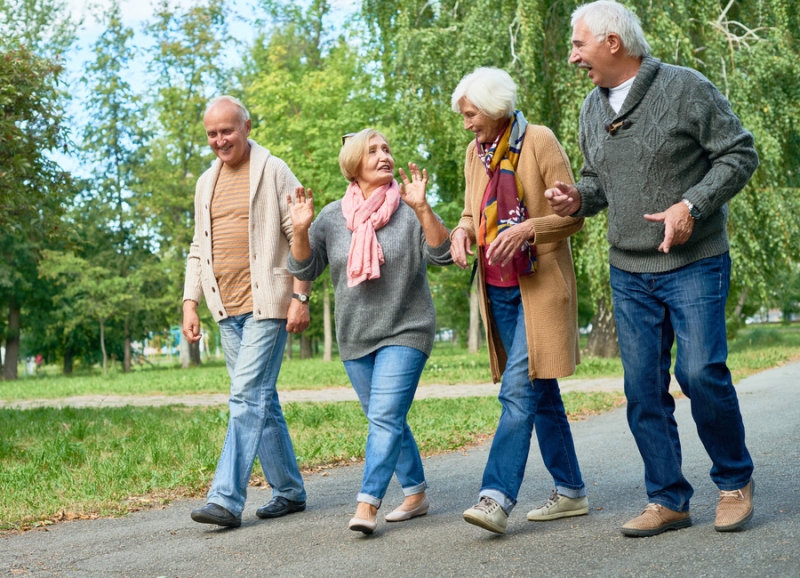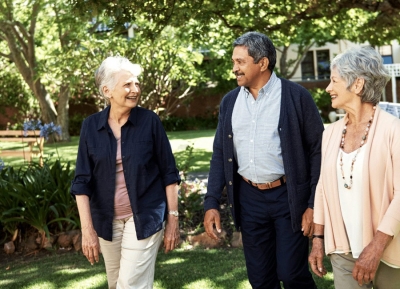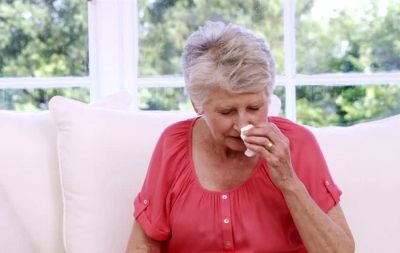One of the best things older adults can do to improve health and vitality is to maintain a walking routine. Many chronic illnesses, diseases, and everyday ailments can be prevented or better managed with moderate-intensity walking. Research also shows that walking has protective benefits for the physical and emotional health of older adults. Let’s take a closer look at these benefits, learn walking safety tips for older adults, and easy ways for older adults to fit a little more walking into their day.
Physical & Emotional Health Benefits of Walking for Seniors
Walking provides the following physical health benefits for older adults:
- Decreases risk of heart disease & stroke
- Strengthens the cardiovascular system
- Helps maintain healthy blood pressure & cholesterol level
- Helps protect bone density
- Supports a healthy body weight
- Helps prevent and manage type 2 diabetes
- Eases arthritis pain & stiffness
- Builds muscle strength
- Strengthens the immune system
Walking also has the following emotional health benefits or older adults:
- Helps with management of stress
- Reduces risk for anxiety
- Reduces risk for depression
- Enhances sleep quality
- Invigorates energy level
- Enhances creativity
- Improves socialization when walking with others
- Supports cognitive function (memory, learning, focus)
- Lowers risk of dementia & Alzheimer’s disease
As you can see, walking improves the older adult’s overall quality of life!
How to Walk for Wellness
When walking for wellness, older adults have a few options for how to proceed. First, always begin with a check-up with your personal physician. Once you’ve got the ‘go ahead,’ you’ll want to wear proper footwear and attire (see Tips, below).
To reap the wellness benefits of walking, older adults want to move at a pace that makes them feel slightly out of breath, but \ still able to hold a “huffy” conversation. Don’t worry if that's not manageable at the start. Rather, focus on moving safely, for as long as is comfortable. Build-up walking endurance by adding 5 minutes to each walk. If you’re not quite ready for 30-minute long daily walks, try some of the walking tricks below to get more steps each day.
3 Tricks for Fitting in a Little More Walking Each Day
You don’t have to take long walks every day. If all you can fit in is 10-15 minute bouts of walking a couple of times throughout your day, research shows that’s just as good as a longer walking routines. A few simple tricks for increasing the amount of walking in your everyday routine include:
- Park further away from store entry areas so you have further to walk from your car
- Use steps instead of an elevator, moving sidewalk, or escalator
- Get up from your chair or desk every hour to move around the house, step outside for a stroll around the block, or do a few chores
8 Fitness Walking Safety Tips for Older Adults
The tips below apply to anyone: If you are just starting a walking program, these tips will get you off on the right foot. If you’ve been walking regularly for fitness, these tips are a good reminder.
One thing we want to emphasize to older adults: Don’t be shy about using assistive supports such as trekking poles, a cane, or even a walker.
- Trekking poles can add to the fitness benefits of walking, especially for those who are still very able-bodied.
- A cane provides stability—and if your health provider says you need it, then use it (there are some very stylish canes on the market!).
- Anyone who requires a walker should not leave home without it—even with a walker, the benefits of walking are too great to stay indoors on the couch.
- Be good to your feet. Proper footwear and footcare can help prevent falls and reduce the chance for gait problems. It also makes walking more enjoyable, so you’ll be more inclined to stick with your walking routine. Walking shoes (or sneakers) should be comfortable and sturdy to provide solid footing and support. If you have foot problems, consider going to an athletic shoe outfitter that specializes in walking and running shoes. A podiatrist can also assess if you need orthotic support. Podiatrists also can recommend a footcare routine to follow before and after your walk.
- Be weather-ready. Even if you live in an area with a pretty constant temperature, you’ll want to be prepared for sudden changes in weather conditions. This is especially true if you walk trails with elevation changes. Consider carrying a lightweight, rain-resistant covering with you. Dress in layers if it a time of year known for sudden shifts in temperature.
- Water is essential. Sip water throughout your walk and replenish lost fluids by drinking extra water (not coffee or soda) in the hours following your walk.
- Carry your ID and an emergency info card. The card should indicate any known medical conditions you may have, contact info for your doctor and a local friend or relative. Carry some cash and a cell phone, especially if you’re walking alone.
- Walk in the light. It’s ideal for older adults to walk before dusk. If walking in the evenings, choose well-lit areas with “people traffic”.
- Be visible to others. During the day, wear light or brightly colored apparel. Reflective apparel, even if it’s just wrist bands, a hat, or a reflective vest, makes you more visible to others—even in daylight, which increases your safety.
- Be aware of your surroundings at all times. When walking outdoors stay attentive by not talking on the phone (or not using it while you walk). If you use headphones, keep the volume low.
- Recruit a walking buddy. Add a health boost to your walk, and increase your safety, by walking with a buddy. Having a buddy promotes social engagement, which is wonderful for emotional wellbeing. If you don’t have a walking partner, let others know your time of departure, where you’re going, and when you plan to be back. In our Everbrook Senior Living Communities, it’s easy to find a walking buddy or group.
Everbrook Senior Living Community Walking Trails
Each of the Everbrook Senior Living Communities has beautiful grounds for walkers. For those who want more variety (or challenge) in their walking routine, you’ll find parks and trail systems that are accessible from your front door to within minutes or a short drive of each of the Everbrook communities.
Colebrook Village in central Connecticut, in the town of Hebron, is within immediate access to a variety of places to walk. Whether it is downtown Hebron, or the hiking trails at Gay City State Park, or along the shoreline…you don’t have to travel far for a beautiful walk!
Cedarbrook Village located in Ware, Massachusetts, is surrounded by rolling hills, river views, and a variety of outlets for easy to vigorous walks. From parks to mountains to spa retreats with beautiful walking grounds—you’ll find it all accessible minutes to a a short drive from Cedarbrook.
Elmbrook Village in the quaint town of Bozrah, Connecticut is accessible to seaside walks as well as park trails, not to mention the lovely grounds at the property, itself. Gardner Lake and Maple Farms Park are two favorite spots for walking and recreating.
Stonebrook Village in Enfield, Connecticut provides a variety opportunities to get your walk in. Wheter you venture downtown or to Enfield Falls or venture along the Windsor Locks Canal, there’s much wildlife, foliage, and sights to enjoy!
We also have Brookmeadow at Blue Hills, in Stoughton, Massachusetts, and Hillsbrook Village in Allenstown, New Hampshire (opening this summer). Both with exceptionally beautiful grounds and access to charming villages and recreational areas suitable for walkers of every stripe!
Resources
American Academy of Family Physicians. Exercise and Seniors. May 2022.
Walking Tip Sheet for Older Adults from HealthyAging.org
Walking Programs for Seniors from HowdyHealth at Texas A&M Life Extension
European Society of Cardiology. Exercise, however modest, found progressively beneficial to the elderly. 15 May 2015.
Fahmy, S. Study: Regular walking nearly halves elderly disability risk. UGA Today. 15 July 2018.







